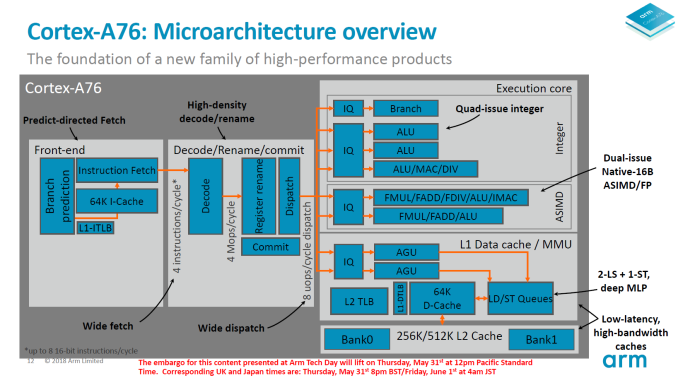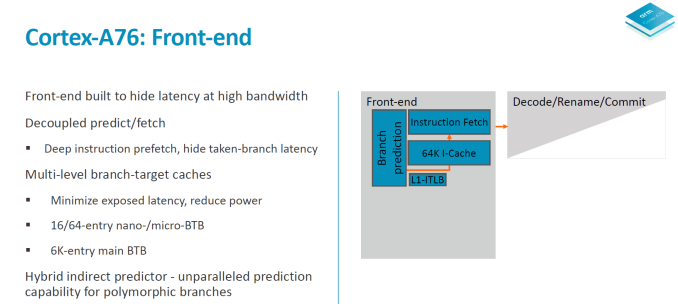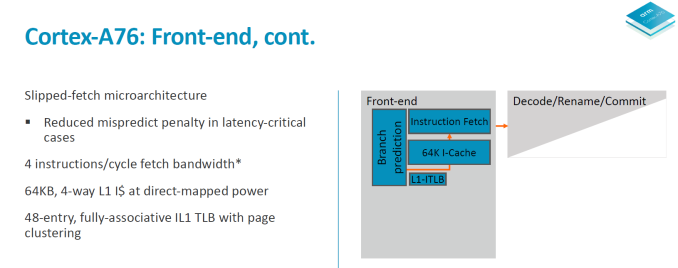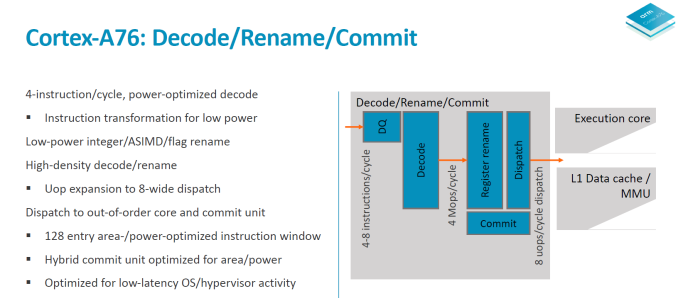Arm's Cortex-A76 CPU Unveiled: Taking Aim at the Top for 7nm
by Andrei Frumusanu on May 31, 2018 3:01 PM EST- Posted in
- CPUs
- Arm
- Smartphones
- Mobile
- SoCs
- Cortex-A76
Cortex A76 µarch - Frontend
Starting off with a rough overview of the Cortex A76 microarchitectural diagram we see the larger functional blocks. The A76 doesn’t look too different than other Arm processors in this regard and the differences come only with details that Arm is willing to divulge. To overly simplify it, this is a superscalar out-of-order core with a 4-wide decode front-end with 8 execution ports in the backend with a total implementation pipeline depth of 13 stages with the execution latencies of a 11 stage core.
In the front-end, Arm has created a new predict/fetch unit that it calls a “predict-directed fetch”, meaning the branch prediction unit feeds into the instruction fetch unit. This is a divergence from past Arm µarches and it allows for both higher performance and lower power consumption.
The branch prediction unit is what Arm calls a first in the industry in adopting a hybrid indirect predictor. The predictor is decoupled from the fetch unit and its supporting large structures operate separate from the rest of the machine – likely what this means is that it will be easier to clock-gate during operation to save on power. The branch predictor is supported by 3-level branch target caches; a 16-entry nanoBTB, a 64-entry microBTB and a 6000 entry main BTB. Arm claimed back in the A73 and A75 generations of branch predictors were able to nearly predict all taken branches so this new unit in the A76 seems to be one level above that in capability.
The branch unit operates at double the bandwidth of the fetch unit – it operates on 32B/cycle meaning up to 8 32b instructions per cycle. This feeds a fetch queue in front of the instruction fetch consisting of 12 “blocks”. The fetch unit operates at 16B/cycle meaning 4 32b instructions. The branch unit operating at double the throughput makes it possible to get ahead of the fetch unit. What this serves is that in the case of a mispredict it can hide branch bubbles in the pipeline and avoid stalling the fetch unit and the rest of the core. The core is said to able to cope with up to 8 misses on the I-side.
I mentioned at the beginning that the A76 is a 13-stage implementation with the latency of an 11-stage core. What happens is that in latency-critical paths the stages can be overlapped. One such cycle happens between the second cycle of the branch predict path and the first cycle of the fetch path. So effectively while there’s 4 (2+2) pipeline stages on the branch and fetch, the core has latencies of down to 3 cycles.
On the decode and rename stages we see a throughput of 4 instructions per cycle. The A73 and A75 were respectively 2 and 3-wide in their decode stages so the A76 is 33% wider than the last generation in this aspect. It was curious to see the A73 go down in decode width from the 3-wide A72, but this was done to optimise for power efficiency and “leanness” of the pipeline with goals of improving the utilisation of the front-end units. With the A76 going 4-wide, this is also Arms to date widest microarchitecture – although it’s still extremely lean when putting it into juxtaposition with competing µarches from Samsung or Apple.
The fetch unit feeds a decode queue of up to 16 32b instructions. The pipeline stages here consist of 2 cycles of instruction align and decode. It looks here Arm decided to go back to a 2-cycle decode as opposed to the 1-cycle unit found on the A73 and A75. As a reminder the Sophia cores still required a secondary cycle on the decode stage when handling instructions utilising the ASIMD/FP pipelines so Arm may have found other optimisation methods with the A76 µarch that warranted this design decision.
The decode stage takes in 4 instructions per cycle and outputs macro-ops at an average ratio of 1.06Mops per instruction. Entering the register rename stage we see heavy power optimisation as the rename units are separated and clock gated for integer/ASIMD/flag operations. The rename and dispatch are a 1 cycle stage which is a reduction from the 2-cycle rename/dispatch from the A73 and A75. Macro-ops are expanded into micro-ops at a ratio of 1.2µop per instruction and we see up to 8µops dispatched per cycle, which is an increase from the advertised 6µops/cycle on the A75 and 4µops/cycle on the A73.
The out-of-order window commit size of the A76 is 128 and the buffer is separated into two structures responsible for instruction management and register reclaim, called a hybrid commit system. Arm here made it clear that it wasn’t focusing on increasing this aspect of the design as it found it as a terrible return on investment when it comes to performance. It is said that the performance scaling is 1/7th – meaning a 7% increase of the reorder buffer only results in a 1% increase in performance. This comes at great juxtaposition compared to for example Samsung's M3 cores with a very large 224 ROB.
As a last note on the front-end, Arm said to have tried to optimised the front-end for lowest possible latency for hypervisor activity and system calls, but didn’t go into more details.














123 Comments
View All Comments
leo_sk - Sunday, June 3, 2018 - link
They had many problems other than target audience. I can give one plus as a counter exampleMatthmaroo - Monday, June 4, 2018 - link
Also Apple has gigantic RD budgetsThink Intel / Qualcomm and AMD are a faction of Apple is size
Matthmaroo - Monday, June 4, 2018 - link
Edit “is” should be ApplesAnd add ARM holding to the list of cpu developers
BillBear - Friday, June 1, 2018 - link
We know from TSMC that moving the A12 to their 7nm process will give Apple some significant improvements before we even consider this year's improvements to their design.>Compared to its 10nm FinFET process, TSMC's 7nm FinFET features 1.6X logic density, ~20% speed improvement, and ~40% power reduction.
http://www.tsmc.com/english/dedicatedFoundry/techn...
joms_us - Friday, June 1, 2018 - link
Nonsense, GB was designed to interpolate scores from worthless tasks that don't mean to real-world scenarios. Even iPhone with A11 is no match in speed and performance versus SD845 and Exynos powered Android phones today. You only use GB to compare two similar platform period. There is no way in hell A11 is faster than Skylake or Ryzen. Only ret@rded people will believe on that.BillBear - Friday, June 1, 2018 - link
>GB was designed to interpolate scores from worthless tasksGeekbench borrows code from popular open source projects and benchmarks that code running against the same workload on multiple platforms.
For instance, Google's open sourced code to render HTML and DOM in Chrome, Google's code to render PDFs in Chrome, the open sourced LLVM compiler Google now builds the Windows version of Chrome with.
Hardly worthless.
joms_us - Friday, June 1, 2018 - link
Oh yeah rendering html, see any speed tests, SD845 phone loads faster than iPhone 8/X. SD845 exports video faster than A11. See my point, just because A9 loads one piece of the whole feature, doesn't mean it it has faster single core than even SD820 which used to have higher score than A9 using prev GB version. See the point? They rigged the scoring system so it would appear Apple SoC is much faster than even Intel or AMD processors LOL.name99 - Friday, June 1, 2018 - link
Comparing Apple cores to Intel for browsers gives the same results as GeekBench.My personal comparisons of Wolfram Player on iPad Pro vs MacBook Pro again confirm GB4 results.
Back when we had SPEC2006 numbers for Apple cores, YET AGAIN they confirmed the GB4 results...
If you don't believe the browser results, nothing is stopping you from running something like jetstream on your own devices (and borrowing someone's iPad Pro or iPhone X, since I assume you wouldn't be caught dead owning one).
https://www.browserbench.org/JetStream/
joms_us - Friday, June 1, 2018 - link
Good now load a similar app and website at the same time on iPhone X and AMD or Intel desktop and come back here. Even SD835 slaughtered the A11 on a side by side comparisons. Again the point is, they multiplied the scores on where Apple SoC is faster by nanosec and call it twice faster than competiton LOL. As if nanosec is noticeable in real life scenario =Dlostmsu - Tuesday, June 5, 2018 - link
You are being unreasonable. Run JetStream on any of your SD8XX devices, and let parent run it on A11, and let's see. Nobody's going to trust your word here against a reasonable suggestion.